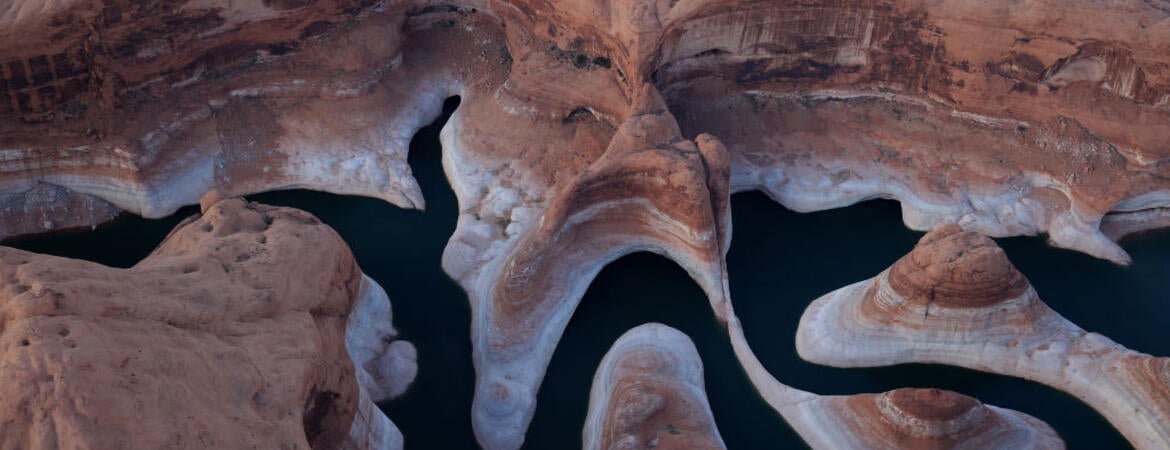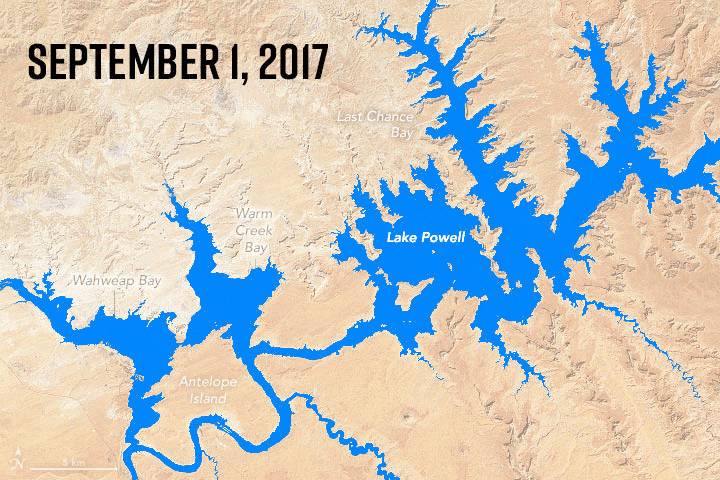
Hit by years of drought exacerbated by a warming planet, the great reservoirs of the Colorado River are at historic lows. The dramatic shrinking of Lake Mead near Las Vegas and Lake Powell above the Grand Canyon has prompted the Biden administration to call for the river basin states to cut their river water use by 25 percent next year or face federally mandated cuts. While the greatest proportion of California’s share goes to the Imperial Valley to irrigate crops, the river is also an important water source for 19 million people in Southern California. We asked UCR water experts from UCR’s School of Public Policy – professors Bruce Babcock, Ariel Dinar, Mehdi Nemati and Kurt Schwabe – to discuss the impacts of the decline of this invaluable resource.
Why should Southern California residents care about low water levels in Colorado River’s reservoirs?
Babcock: Southern California residents depend on imported water from the Colorado River, the Owens River, and the Feather River. All three sources have been in stress because of two years of short-run drought and many years of a longer-term drought. The supplies just are not there. Shortages on the Colorado cannot easily be made up by alternative supplies because supplies are tight everywhere. The only way to balance water supply and water demand is to build more supply or decrease demand. Additional supply, such as desalination plants, increased recycling, and investments in groundwater storage is expensive. Cutting demand means reducing agricultural production and changing urban water use. So Southern California residents have a large stake in decisions that need to be made.
Schwabe: To add to what Professor Babcock said, low water levels can also mean less hydropower from two dams that operate on the Colorado and provide, combined, renewable electricity to over 13 million people. Both Glen Canyon Dam at Lake Mead and Hoover Dam at Lake Powell are a significant source of electricity to southern California and the southwest. As the water levels decrease, the efficiency of the dams decreases, raising electricity prices from these two sources. Furthermore, as the supply of power decreases from these two renewable resources, we are likely to see a shift toward more fossil-fuel based electricity generation and, with it, carbon emissions.
Nemati: The cuts could have devastating impacts both on agricultural and urban users. For most the farmers in the Imperial Valley, Colorado River water is their only water source. For urban users, this could mean more water-use restrictions and conservation. As mentioned by Professor Babcock, frequent, intense, and long droughts resulted in low imports from Northern California, and now both import systems are under stress. Starting June 1, 2022, the Metropolitan Water District of Southern California has implemented unprecedented watering restrictions for the six million Southern Californians who rely on the parched State Water Project, which funnels water from Northern California south and in 2022 reduced deliveries to just 5% of requested supplies. Reductions of delivery from the Colorado River could result in restrictions for the customers that receive Colorado River water.
How near are these reservoirs to “deadpool” status -- a situation in which the levels are so low that water will no longer flow out over the Hoover Dam at Lake Mead and the Glen Canyon Dam at Lake Powell?
Schwabe: Currently, Lake Mead is at about 1,045 feet above mean sea level, orMSL, about 20 feet below this time in 2021, and 35 feet below this time in 2020. “Deadpool” for Lake Mead is 895 feet MSL. Lake Powell, the upstream and smaller dam and reservoir, is currently at around 3,530 feet MSL, about 40 feet lower than the previous year, and with deadpool at 3,370 feet MSL. Yet, it should be emphasized that these two reservoirs have been propped up a bit by increases in releases from smaller dams further upstream, releases that likely won’t be available next year. Both dams are at historic lows, with Lake Mead’s elevation about 28% of its normal elevation, and Lake Powell about 24% of its normal elevation.
What do these very low water levels mean for San Diego and other California cities that rely heavily on Colorado River water?
Schwabe: Certainly, continued and likely increased efforts in water conservation. Furthermore, and as Professor Babcock mentioned above, water prices might increase because Colorado River water is often a low-cost source of water supply so as it decreases, a larger fraction of the water supply is reliant on more expensive alternatives, such as desalinization for San Diego. Because increasing water supplies in any particular area require long-term investments, water conservation is typically the only way to deal with short-run shortages. One other option that has and will likely increase in prominence to deal with these shortages is voluntary water purchases from irrigated agriculture. This can be achieved relatively quickly and is something Southern California agencies such as the Metropolitan Water District of Southern California and the San Diego County Water Authority have and continue to pursue, with success.
Do federal requirements for the Colorado River basin states, including California, to cut water consumption by 25%—some 2 million to 4 million acre-feet—go far enough?
Schwabe: For the short run, probably. But, because of the overestimate of the actual flow of water in the Colorado when the initial allocations were determined back in 1922 under the Colorado River Compact — they grossly overestimated the amount of flow — and given that the allocations also did not account for losses due to evaporation (they significantly underestimated that amount) which is a significant issue for the water stored in Lakes Mead and Powell, a substantial readjustment in water allocations needs to take place so that we aren’t perpetually in this sort of crisis mode.
Dinar: In my opinion, the more important question is how water cuts should be distributed and allocated among the seven riparian states (adjoining the river, rather than a uniform cut across all states. It is possible that given the relative efficiency of water use among riparian states, and even within each of the states, that a better policy would be to distinguish among states and let some face lower cuts than others. In the longer run, such dynamic cuts could adjust to scarcity conditions that may change over time.
Can Colorado River water stocks be replenished by a wet winter? Or has climate change made the river a water resource that shouldn’t be relied upon?
Dinar: This is a tricky question that can be answered by models that can be calibrated, using historical trends in water availability in the basin. It is hard to provide a solid answer without modeling of flow replenishments on annual basis. Just as anecdotal information, since the 1922 treaty that allocated the water of the Colorado among upper and lower states assuming a fixed flow of 16.46 million acre feet per year, only 12 of the 80 years appear with flow larger than 16.46 (Rightnar and Dinar, 2020). As is expected by climate scientists, expect that flow in the Colorado will only decline overtime.
Schwabe: I think the river can still be relied upon, even under climate change, but we should base our “reliance” on more accurate and up-to-date information as Professor Dinar emphasizes. Likely, our “reliance” will need to decrease in the total amount of water. While most climate models predict that the overall level of precipitation won't change significantly under climate change, there will be less frequent yet more intense precipitation events. The region also will be much hotter, and with that increase in temperature, runoff to the river will decrease.
If California abandoned grass lawns and other thirsty landscapes and replaced them with water-wise native plants, would the state’s water scarcity problem be solved?
Babcock: Native plants would be ubiquitous if I oversaw California landscaping. But would this alone solve water scarcity? No. Agriculture is the primary user of water in California. Water balance adjustments will take place primarily there. However, it might be in urban water districts’ own interests to encourage conversion of yards to native plants. It should be an easy sell. Native plants are beautiful, support wildlife and use substantially less water. But people get to choose what to do with their yards. A visit to your local nursery makes clear that traditional, high-water-using landscaping plants are still high in demand. But many nurseries also have native plant sections. This reflects increased market demand for natives as more people realize their benefits. One policy option that would increase native plantings would be to subsidize their adoption. This could be justified if the cost of the water saved by subsidizing property owners to move to natives is less than the cost of finding new supplies. I have not made this calculation, but it certainly seems possible in some water districts. Landscape maintenance companies would need to transition from caring for water-intensive plantings, such as lawns, tropical shrubbery, and some non-native trees, to installing and caring for plants that use little summer water, such as manzanita, California lilac, sages, and fruit-bearing natives such as blue elderberry.
Similarly, many farms in the Imperial and Palo Verde valleys use water-intensive flood irrigation techniques and grow thirsty crops, such as alfalfa. What would be impact of phasing in drip irrigation systems and other more water-wise methods and choosing more water-stingy crops?
Babcock: Growers adopt irrigation systems that are best suited for the crops they choose to grow. The system that is judged to be best suited varies with both agronomic and economic factors. The price of crops often determines which crops growers want to grow. If there are alternative irrigation systems that are feasible to use to grow the crop, then the system that gives the grower the highest economic return will tend to be chosen. We should expect increasing water scarcity—and associated increase in water costs—to lead to a change in the choice of crops and irrigation systems used to grow the crops. Phase in of crops that use less water than alfalfa will depend on how much local buyers are willing to pay for alfalfa. Large local livestock operations create a strong demand for locally produced forage crops.




